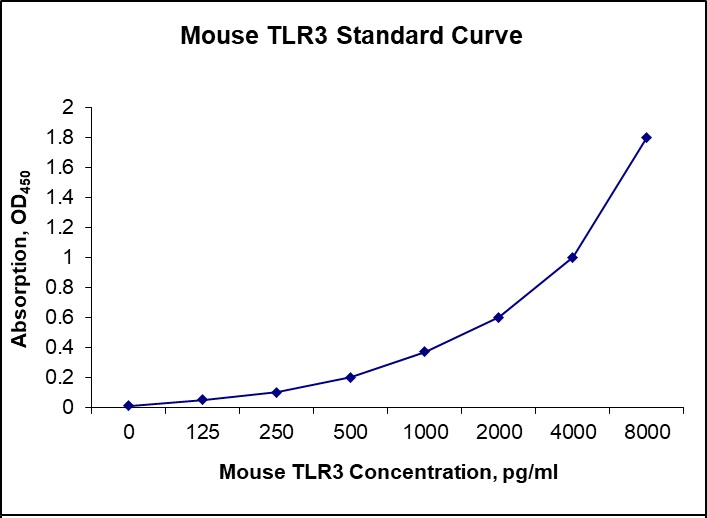Nori Mouse TLR3 ELISA Kit
$461.00 – $832.00
DataSheet CoA SDS
This ELISA kit is for quantification of TLR3 in mouse. This is a quick ELISA assay that reduces time to 50% compared to the conventional method, and the entire assay only takes 3 hours. This assay employs the quantitative sandwich enzyme immunoassay technique and uses biotin-streptavidin chemistry to improve the performance of the assays. An antibody specific for TLR3 has been pre-coated onto a microplate. Standards and samples are pipetted into the wells and any TLR3 present is bound by the immobilized antibody. After washing away any unbound substances, a detection antibody specific for TLR3 is added to the wells. Following wash to remove any unbound antibody reagent, a detection reagent is added. After intensive wash a substrate solution is added to the wells and color develops in proportion to the amount of TLR3 bound in the initial step. The color development is stopped, and the intensity of the color is measured.
Alternative names for TLR3: Toll-like receptor 3 (TLR3), CD283
This product is for laboratory research use only not for diagnostic and therapeutic purposes or any other purposes.
- Description
- How Elisa Works
- Product Citations
- Reviews (0)
Description
Nori Mouse TLR3 ELISA Kit Summary
Alternative names for TLR3: Toll-like receptor 3 (TLR3), CD283
| Assay Type | Solid Phase Sandwich ELISA |
| Format | 96-well Microplate or 96-Well Strip Microplate |
| Method of Detection | Colorimetric |
| Number of Targets Detected | 1 |
| Target Antigen Accession Number |
Q99MB1 |
| Assay Length | 3 hours |
| Quantitative/Semiquantitative | Quantitative |
| Sample Type | Plasma, Serum, Cell Culture, Urine, Cell/Tissue Lysates, Synovial Fluid, BAL, |
| Recommended Sample Dilution (Plasma/Serum) | No dilution for sample <ULOQ; sufficient dilution for samples >ULOQ |
| Sensitivity | 25 pg/mL |
| Detection Range | 125-8000 pg/mL |
| Specificity | Natural and recombinant mouse TLR3 |
| Cross-Reactivity | < 0.5% cross-reactivity observed with available related molecules, < 50% cross-species reactivity observed with species tested. |
| Interference | No significant interference observed with available related molecules |
| Storage/Stability | 4 ºC for up to 6 months |
| Usage | For Laboratory Research Use Only. Not for diagnostic or therapeutic use. |
| Additional Notes | The kit allows for use in multiple experiments. |
Standard Curve
Kit Components
1. Pre-coated 96-well Microplate
2. Biotinylated Detection Antibody
3. Streptavidin-HRP Conjugate
4. Lyophilized Standards
5. TMB One-Step Substrate
6. Stop Solution
7. 20 x PBS
8. Assay Buffer
Other Materials Required but not Provided:
1. Microplate Reader capable of measuring absorption at 450 nm
2. Log-log graph paper or computer and software for ELISA data analysis
3. Precision pipettes (1-1000 µl)
4. Multi-channel pipettes (300 µl)
5. Distilled or deionized water
Protocol Outline
1. Prepare all reagents, samples and standards as instructed in the datasheet.
2. Add 100 µl of Standard or samples to each well and incubate 1 h at RT.
3. Add 100 µl of Working Detection Antibody to each well and incubate 1 h at RT.
4. Add 100 µl of Working Streptavidin-HRP to each well and incubate 20 min at RT.
5. Add 100 µl of Substrate to each well and incubate 5-30 min at RT.
6. Add 50 µl of Stop Solution to each well and read at 450 nm immediately.
Background:
Toll-like receptor 3 (TLR3) also known as CD283, is a member of the Toll-like receptor family of pattern recognition receptors of the innate immune system (1). TLRs recognize pathogen-associated molecular patterns (PAMPs) that are expressed on infectious agents and mediate the production of cytokines necessary for the development of effective immunity. TLR3 is found in phagosomes (2), where the acidic pH enables binding of internalized double stranded RNA and mRNA from viruses, parasites, and necrotic virally infected cells (3-6, 8, 11). Ligand binding by TLR3 induces receptor dimerization (3, 7, 8) leading to the release of inflammatory cytokines and dendritic cell maturation (4, 6, 9). TLR3 is expressed in dendritic cells, macrophages, microglia, and astrocytes (9-11) and is upregulated by IFNβ and LPS (4, 10). TLR3 expression is also induced by lung fibroblasts and epithelial cells by respiratory syncytial virus infection. TLR3 recognizes double-stranded RNA, a form of genetic information carried by some viruses such as reoviruses. Upon recognition, TLR3 induces the activation of NF-κB to increase production of type I interferons which signal other cells to increase their antiviral defenses. Double-stranded RNA is also recognized by the cytoplasmic receptors RIG-I and MDA-5 (12). TLR3 displays a protective role in mouse models of atherosclerosis. In addition, TLR3 activators show effects on Mouse vascular cells (13).
References
- Rock FL, et al. Proc. Natl. Acad. Sci. U.S.A. 95 (2): 588–93.
- Nishiya, T. et al. (2002) J. Biol. Chem. 280:37107.
- de Bouteiller, O. et al. (2005) J. Biol. Chem. 280:38133.
- Alexopoulou, L. et al. (2001) Nature 413:732.
- Aksoy, E. et al. (2005) J. Biol. Chem. 280:277.
- Kariko, K. et al. (2004) J. Biol. Chem. 279:12542.
- Choe, J. et al. (2005) Science 309:581.
- Bell, J.K. et al. (2005) Proc. Natl. Acad. Sci. 102:10976.
- Farina, C. et al. (2005) J. Neuroimmunol. 159:12.
- Heinz, S. et al. (2003) J. Biol. Chem. 278:21502.
- Wang, T. et al. (2004) Nat. Med. 10:1366.
- Cole JE, et al. Proc Natl Acad Sci U S A 108 (6): 2372–7
- Choe J, et al. Science 309 (5734): 581–5.
Be the first to review “Nori Mouse TLR3 ELISA Kit”
You must be logged in to post a review.




























Reviews
There are no reviews yet.